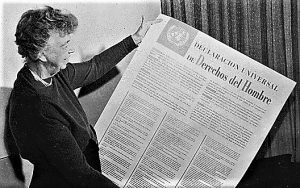Public international law
When we refer to public international law, it is also important to know what international law is. This type of law is formed by a group of international legal norms that regulate the laws that states have. All these agreements and treaties, as well as protocols, form part of international law. Thus, public international law is a system that helps to control the way in which states behave in their relations with others.

Related topics
Administrative law, criminal procedural law, labor law, public international law, private international law, right of petition, roman law, social law
What is public international law?
Public international law is the type of law that regulates the way States and other international subjects behave in their own competences and in mutual relations to seek peace and international cooperation.
About public international law
Public international law consists of the legal system whose main function is to control the way in which all States and other subjects of an international nature behave. It is in charge of regulating the different competences and the types of relations established between them, based on some common aspects and values, in order to achieve international peace and cooperation through norms born from specific international sources. In other simpler words, we could say that it consists of the legal system of the international community.
Public international law has an important sociological basis of international character, in what it is known as the “human group“, which is constituted by a community fund and an organic, societal and artificial realization, from which it is born and for which this legal norm is formed.
Characteristics
The main characteristics that we can observe in public international law are the following:
- There must be a common good for cooperation among States.
- Relationships are subject to general laws that relate to the development of society.
- States must foster harmonious relations and maintain peaceful development.
- There must be adequate relations of a political nature that are basic to the life of States.
- It is as independent as governments, whether republican or monarchic.
- It is a right of coordination; it does not have centralized organs and the responsibility is collective.
- There is also a collective security, it is dynamic and legal.
- It has relativity of international legal duties.
Backgrounds
It is considered that the history of public international law dates back to two well-defined sources or trends. One was the origin of international law itself, which originated in the old international states; and the other, in the sixteenth century, when the great European states were formed. It is at the moment when different communities or different societies begin to relate to each other that public international law is born.
The oldest international treaty on record was made in Mesopotamia, between the king of Elba and the king of Assyria, in which they established friendly and commercial relations, establishing joint sanctions for those who committed crimes.
History
The history of international public law dates back to Mesopotamia when Lagash and Umma made a treaty in order to recognize a border and also established a series of punishments or sanctions supposedly indicated by the gods. There was also a treaty between Egypt and the kingdom of the Hittites, at the time it was a treaty of peace and alliance, a pact to prevent aggressions and in it, it was dictated an extradition regime. In India, with the Manu code, new forms are born to regulate wars peacefully and in China began to appoint ambassadors and other officials.
During the Middle Ages, international public rights were boosted by trade and marine transport. Later on, the Magna Carta and the mercantile law were created, in which it was established that any merchant who was a foreigner could reside temporarily in England and traffic without taxes. The intercursus magnus of 1495 was drawn up by Henry VIII in which it was established that merchants could reside freely, buy and sell goods.
Branches
The branches of public international law are as follows:
- Financial law
- Criminal law
- Constitutional Law
- Administrative Law
- Procedural
Principles of public international law
The basic principles of public international law are as follows:
- Peaceful coexistence: is the form of coexistence that occurs between the different States that have different political, economic and social systems respecting public international law.
- Sovereign equality.
- Independence.
- Self-determination: these are the rights of peoples to freely choose their political, economic and social regimes.
- Territorial integrity.
- Conservation rights: the State acquires the necessary means to attend to its own defense against internal and external enemies.
- Reciprocal respect.
- Right to nationalization: the power of peoples to use their wealth and resources.
Sources
The sources of public international law are:
- International treaties, which are the first and most important source of public international law.
- Custom.
- The general principles of law, in other words, those which have not been accumulated in international treaties or indicated by custom, and which are also recognized by civilized nations.
- The national legislation of States.
- Advisory opinions of the International Court of Justice.
- Jurisprudence.
- Diplomatic acts of States.
Functions
One of the main functions is to maintain the relations of the international social group, of which the main legal postulate is to maintain international peace and security. The second function is to separate the State from the demands coming from the international environment so that, objectives of common interest can be achieved for the social group, whose main legal postulate is general cooperation. And the last function of public international law is to integrate, in order to promote a consensus regarding the essential collective interests of the international social group with the objective of creating and protecting the imperative law.
Subjects
The subjects of public international law are as follows:
- The State, which is considered to be the primary subject of private international law.
- International Intergovernmental Organizations or associations that have been created by an international agreement.
- Belligerent Communities.
- National Liberation Movements.
- Holy Headquarters, which includes Vatican City and the Sovereign Order of Malta are considered and mentioned separately for historical reasons.
- All entities where certain characteristics, elements and attributes proper to the system are given are also subjects of public international law.
Doctrine
There are three doctrines on which public international law is based, one of them is the unnaturalistic doctrine, the second were the positivist doctrines and finally, we find the systematic positivist doctrines.
Public order
It is the state that has to ensure the application of public international law depending on the legal system and they do so through judges and courts. It is important to bear in mind that no rule of law can ever be applied in a state when it causes damage to its order.
Importance of public international law
Public international law is important because it acts on the basis of its values that help to structure the relationships between members belonging to the international community. It is a means of ensuring that an international community does not fall into the hands of sovereign States. Its main right is to ensure international peace and security by functioning as a shaper of the international social order through the creation of legal norms through the sources of international law.
Examples include
Some examples of international law are the following:
- Air Spaces between countries.
- Maritime spaces between countries.
How to cite this article?
Briceño V., Gabriela. (2019). Public international law. Recovered on 23 February, 2024, de Euston96: https://www.euston96.com/en/public-international-law/









